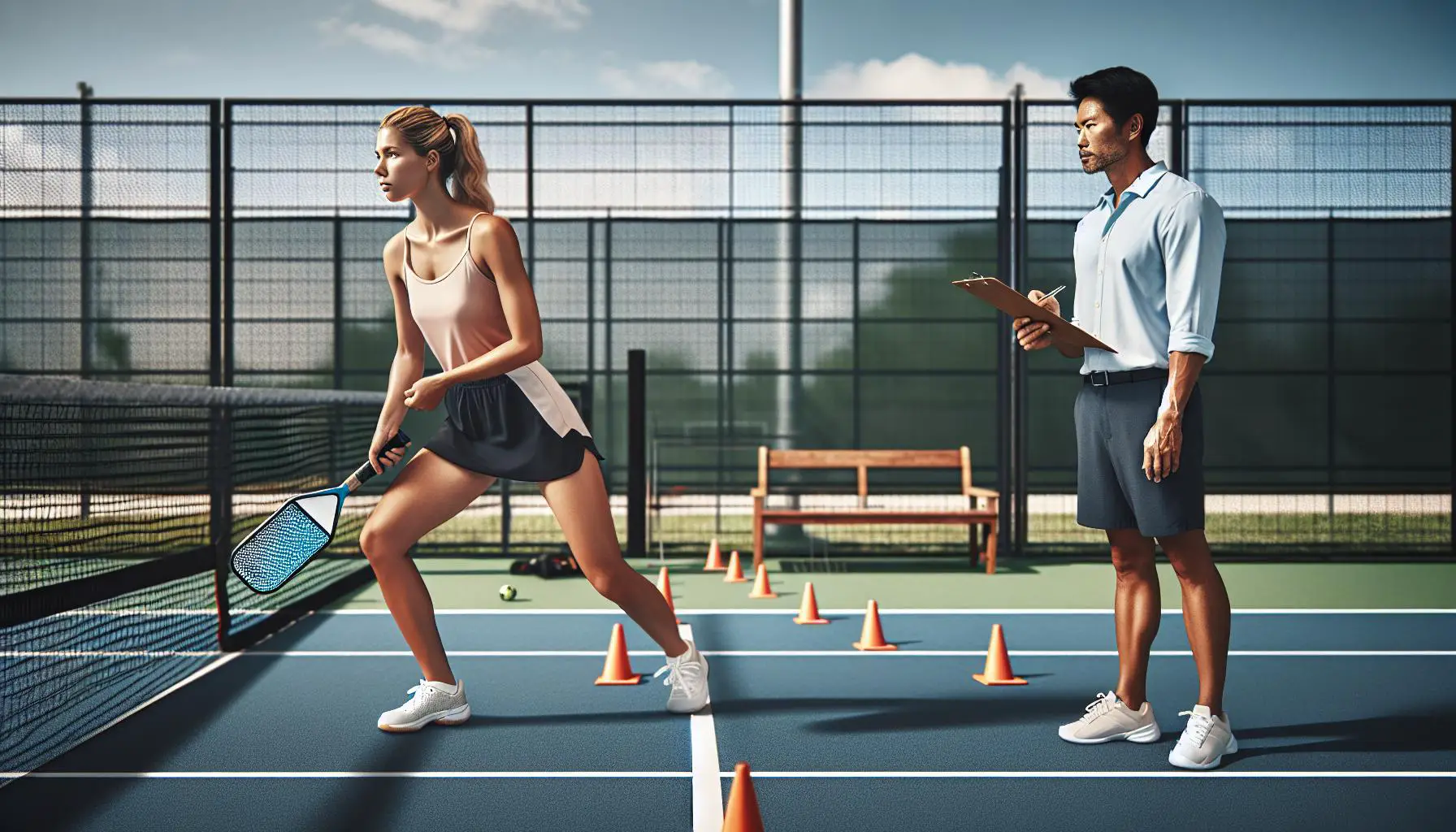In the fast-paced world of pickleball, understanding the nuances of the game can give players a competitive edge. One such nuance is handling net balls during service, a situation that can often cause confusion among both seasoned players and newcomers alike.
The rules surrounding net balls in service are designed to keep the game fair and flowing smoothly. Whether you’re just picking up a paddle for the first time or you’re looking to refine your game, it’s crucial to get a grip on how these specific rules play out on the court. Let’s dive into the essentials of handling net balls in service in pickleball, ensuring you’re well-prepared for your next match.
Understanding Net Balls in Service
In the dynamic world of pickleball, mastering the rules surrounding net balls during service lays the foundation for a solid game plan. For many, the intricacies of these rules can seem daunting at first, but they’re designed with fairness and fluid gameplay in mind. When a ball, served with precision and skill, clips the net but still lands in the appropriate service box, it’s referred to as a “let.” Unlike tennis, in pickleball, this scenario doesn’t call for a service redo. Instead, the ball is still in play, injecting an additional layer of strategy and quick thinking into the game.
This aspect of pickleball underscores the importance of being ready and alert at all times. Players can’t afford to pause or lose focus following a net ball during service, as doing so could easily cost them valuable points. It also highlights the skill in serving; aiming for a serve that just grazes the net can be a tactical move, making it more challenging for the opponent to return.
Adapting to this rule requires practice. Players should spend time during their training sessions working on their reaction times and their ability to continue play seamlessly after a net ball during service. Drills that simulate these scenarios can be incredibly beneficial, helping players to internalize the rule and react instinctively during match play.
Why This Rule Matters
Understanding and adapting to the rule regarding net balls in service is crucial for several reasons:
- It keeps the game moving. Allowing play to continue after a net ball prevents unnecessary interruptions, maintaining the pace and flow of the game.
- It adds an element of surprise. The unpredictability of a serve that clips the net can lead to exciting exchanges and test the agility and preparedness of the opposing player.
- It encourages skill development. Mastering service techniques that can subtly use the net to one’s advantage, without committing a fault, pushes players to enhance their serving skills.
In essence, the rule not only serves to maintain fairness but also to elevate the level of play by challenging players to adapt to and capitalize on unforeseen circumstances during the game.
- Reaction drills. These can help improve your speed and agility, making it easier to adjust to net balls in real-time.
- Targeted serving practice. Aim for low,
Importance of Handling Net Balls Correctly

In pickleball, the fine line between a winning serve and a fault can sometimes hinge on how a player handles a net ball during service. When a ball served grazes the net and lands in the appropriate service box, it’s a clear opportunity for both the server and the receiver. For the server, it represents a second chance to keep the rally going without conceding a fault. For the receiver, it’s an abrupt test of their readiness and adaptability. This dynamic adds a thrilling layer to the game, emphasizing not just skill but also quick reflexes and strategic foresight.
Handling net balls correctly is paramount for several reasons. Firstly, it keeps the gameplay continuous. In many racket sports, a net serve would typically lead to a halt in play and a redo of the serve. However, pickleball’s unique rule regarding net balls, often called a “let,” encourages players to maintain their focus and stay on their toes, ready to spring into action at a moment’s notice. This continuous play rule not only speeds up the game but also adds an element of unpredictability that can be both a challenge and an excitement for players.
Secondly, mastering the art of dealing with net balls can significantly boost a player’s confidence and agility on the court. Knowing that they can capably handle a serve that clips the net, landing softly in the service box, allows players to remain composed under pressure. It trains their mind and body to respond swiftly, transitioning from a moment of potential disruption to seizing control of the rally.
To achieve proficiency in handling net balls, players are encouraged to incorporate specific drills into their practice routines. Drills that focus on reaction time, quick lateral movement, and precise ball control can be particularly beneficial. For instance, players might practice rapid returns of softly hit balls that mimic the trajectory of a net ball, helping them develop the finesse and quick reflexes needed for these plays.
Moreover, understanding the strategic advantages of handling net balls effectively can be a game-changer. Players who excel in this aspect can turn a serendipitous net ball into a strategic play, using the momentary uncertainty to their advantage. They might opt for an unexpected shot placement, catching their opponent off guard and gaining the upper hand in the rally.
Rules and Regulations
In the game of pickleball, understanding the rules and regulations surrounding service, especially in the context of net balls, is crucial for players hoping to gain a competitive edge. When serving, the ball must clear the non-volley zone, including the line, and land within the bounds of the diagonal service court opposite the server. However, if during a serve the ball hits the net and still lands in the appropriate service box, it is termed a “let” and the serve is replayed without penalty to the server.
This rule might seem straightforward, but it introduces a strategic layer to serving that can significantly impact gameplay. Unlike in sports like tennis, pickleball allows for the serve to be replayed when hitting the net as long as the ball lands in the correct service area, leading players to potentially take riskier serves aimed at catching their opponents off-guard.
Net Balls During Service: Impact on Gameplay
The treatment of net balls during service can lead to a variety of strategic decisions for both the server and the receiver. For the server, knowing that a net ball that lands correctly will not penalize them encourages experimenting with serve speeds and angles. On the other hand, receivers must always be prepared to react swiftly to serves that may unpredictably bounce after hitting the net. This rule emphasizes the importance of agility and adaptability in pickleball, rewarding players who are able to anticipate and react to net balls with accuracy and speed.
Practicing for Perfection
Given the potential impact of net balls on the flow and strategy of the game, players are encouraged to incorporate specific drills into their practice routines that focus on both serving with accuracy under pressure and responding to net balls effectively. Such drills might include:
- Serving Drills: Practicing different types of serves, aiming to skim the net to mimic a “let” situation, helps in developing a more unpredictable serve.
- Reaction Drills: Setting up scenarios where a player must quickly respond to a serve that has hit the net and changed direction, enhancing their agility and adaptability during actual gameplay.
Techniques for Addressing Net Balls

In the world of pickleball, mastering the technique for handling net balls during service not only sets the stage for a dynamic game but also adds a critical layer of strategy for players. This section delves into various methods players can adopt to effectively manage these challenging situations.
Firstly, anticipation and quick reflexes are pivotal. Players must stay on their toes, ready to move in any direction. They need to develop a keen sense of awareness, predicting where the ball might land after a net ball incident. Practicing drills that simulate net balls can significantly improve their reaction time and anticipation skills.
Another crucial approach is perfecting the serve. While it may sound counterintuitive, aiming the serve slightly higher over the net minimizes the chances of a net ball and forces the opponent to react to a more direct, assertive serve. However, this technique doesn’t eliminate net balls entirely but prepares the server by refining their serving skills.
Practicing serve recovery is equally essential. Once the ball hits the net and still lands in the correct service area, players must be ready to engage immediately. Drills focusing on quick recovery after a net ball helps players transition seamlessly from serving to rallying, maintaining their composure and keeping the pressure on their opponent.
Specifically, players can work on:
- Fast Footwork: Enhancing their ability to quickly adjust position and balance is crucial for effectively returning to a ready stance after a net ball.
- Predictive Skills: Learning to read the opponent’s positioning and potential return shots allows the server to prepare strategically for the next move.
- Serve Variations: Experimenting with different serve techniques, including spin and power variations, enables players to be unpredictable and more adept at handling net balls.
Remember, practice makes perfect. Incorporating these techniques into regular training sessions will not only improve a player’s ability to deal with net balls but also boost their overall performance on the court. Engaging in drills that mimic game-like scenarios, where net balls are a possibility, helps players build muscle memory and mental resilience.
Coaches often highlight the importance of mental preparation alongside physical readiness. Viewing net balls as opportunities rather than setbacks can significantly change how players approach their serve. This mindset shift encourages players to remain positive and proactive, seeing each net ball as a chance to demonstrate their skill and adaptability.
Practice Drills to Improve Net Ball Handling

In the journey to mastering pickleball, players must dedicate time to practice drills specifically designed to improve their net ball handling skills. Coaches and experienced players often highlight the significance of drill-based learning, as it allows for focused improvement in areas identified as weak spots. Among these drills, some are particularly effective in enhancing a player’s reflexes and strategic thinking when confronted with a net ball during service.
One popular drill involves Server vs. Receiver scenarios, where the server intentionally aims the ball to clip the net, simulating net balls in a controlled environment. This exercise requires the receiver to stay alert, anticipate the ball’s trajectory post-net contact, and make a successful return. Coaches recommend incorporating this drill into regular practice sessions, as it helps players develop quicker reaction times and adaptability in real-game situations.
Another drill focuses on footwork and positioning. Players are tasked with moving rapidly towards the net, following a net ball serve, to practice their ability to quickly get into an optimal position for the next shot. This drill highlights the importance of agility and proper court positioning, skills that are crucial when dealing with unpredictable net balls.
To sharpen reflexes and improve hand-eye coordination, rapid-fire drills are highly recommended. In this setup, one player rapidly hits a series of soft balls to another player at the net, aiming to simulate the erratic movement of net balls. The receiving player must then return these balls as accurately and quickly as possible, honing their skills in managing unexpected, fast-paced shots.
Drill Implementation and Routine
For best results, players should incorporate these drills into their regular practice routine, dedicating specific sessions to focus solely on net ball scenarios. Coaches suggest setting up a drill schedule that alternates between the drills mentioned, ensuring a balanced development of skills.
A recommended routine might look something like this:
- 15 minutes of Server vs. Receiver scenarios
- 10 minutes focusing on footwork and positioning
- 20 minutes of rapid-fire drills
To track progress, players are encouraged to note their success rates and areas of difficulty. This not only helps in identifying improvement over time but also in pinpointing specific aspects of net ball handling that require additional work.
Conclusion
Mastering net balls in pickleball isn’t just about reacting in the moment; it’s about being prepared for anything the game throws your way. The drills outlined offer a roadmap to enhancing those crucial skills that can turn challenging net balls into strategic advantages. By dedicating time to practice and evaluating progress, players can elevate their game to new heights. Remember, every drill is a step closer to not just handling but excelling in net ball scenarios. So grab your paddle, hit the court, and let the drills guide you to becoming a more formidable pickleball player.














0 Comments